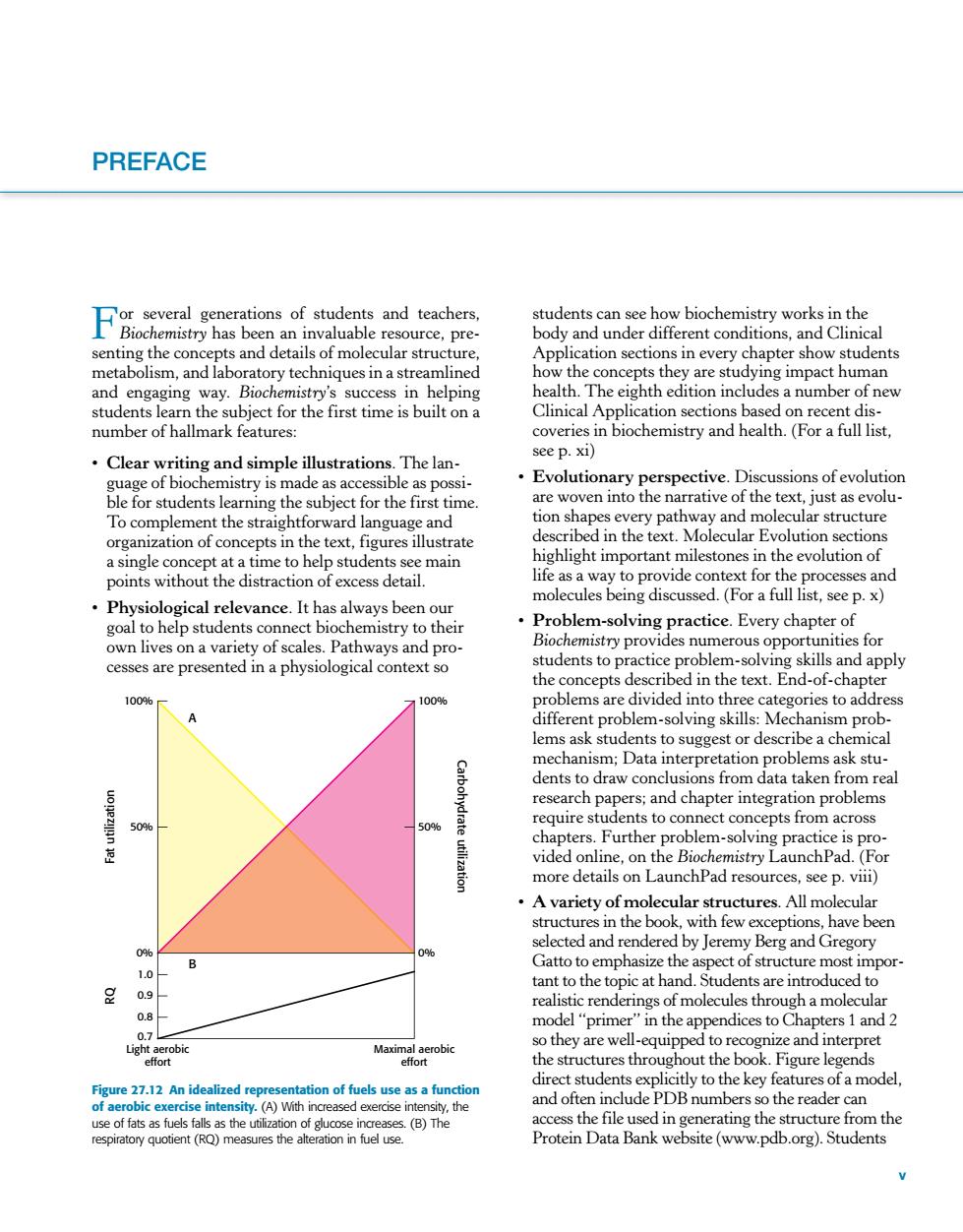正在加载图片...

PREFACE ryaee students can see how biochemistry works in the body and under different conditions,and Clinical are stu elping nev stry i Evolutionary perspective.Dis cussions of evolution ewoven into the h ext,Just as evolu To complement the straightforward language and organization of concepts in the text,figures illustrate lar eyo milesto in the evolution of life as a way to provide context for the cesses and molecules being discussed.(For a full list,see p.x) Physiological relevance.It has always been ou goal to help students connect biochemistry to thei practice Every apt own lives on a variety of scales.Pathways and pro- tudents to r cesses are presented in a physiological context so skills and appl the concents described in the text End-of-chant 100% 004 problems are divided into three categories to address blem-solving skills:Mechanism prob ems a stu s to suggest or describe a ch emica con 50% ire studen s to co chapters.Further problem-solvin is pro vided online,on the Biochemistry LaunchPad.(For more details on LaunchPad resources.see p.viii) A variety of molecular st ures all molecular uctures in the book with few e ceptions,have been selected and rendered by Jeremy Berg and Gregory Gatto to emphasize the aspect of structure most impor. 10 tant to the topic at hand.Students are introduced to real sicrenderingsofmolcudlsthroughamoleculg in the appendi ces to( tey are wel olicitly to the key fea of a model tation of fuels use as a funct (幼 and often include pDB numbers so the reader can bic exercise inte eased exerc se inte access the file used in generating the structure from the Protein Data Bank website(www.pdb.org).Studentsv For several generations of students and teachers, Biochemistry has been an invaluable resource, presenting the concepts and details of molecular structure, metabolism, and laboratory techniques in a streamlined and engaging way. Biochemistry’s success in helping students learn the subject for the first time is built on a number of hallmark features: • Clear writing and simple illustrations. The language of biochemistry is made as accessible as possible for students learning the subject for the first time. To complement the straightforward language and organization of concepts in the text, figures illustrate a single concept at a time to help students see main points without the distraction of excess detail. • Physiological relevance. It has always been our goal to help students connect biochemistry to their own lives on a variety of scales. Pathways and processes are presented in a physiological context so students can see how biochemistry works in the body and under different conditions, and Clinical Application sections in every chapter show students how the concepts they are studying impact human health. The eighth edition includes a number of new Clinical Application sections based on recent discoveries in biochemistry and health. (For a full list, see p. xi) • Evolutionary perspective. Discussions of evolution are woven into the narrative of the text, just as evolution shapes every pathway and molecular structure described in the text. Molecular Evolution sections highlight important milestones in the evolution of life as a way to provide context for the processes and molecules being discussed. (For a full list, see p. x) • Problem-solving practice. Every chapter of Biochemistry provides numerous opportunities for students to practice problem-solving skills and apply the concepts described in the text. End-of-chapter problems are divided into three categories to address different problem-solving skills: Mechanism problems ask students to suggest or describe a chemical mechanism; Data interpretation problems ask students to draw conclusions from data taken from real research papers; and chapter integration problems require students to connect concepts from across chapters. Further problem-solving practice is provided online, on the Biochemistry LaunchPad. (For more details on LaunchPad resources, see p. viii) • A variety of molecular structures. All molecular structures in the book, with few exceptions, have been selected and rendered by Jeremy Berg and Gregory Gatto to emphasize the aspect of structure most important to the topic at hand. Students are introduced to realistic renderings of molecules through a molecular model “primer” in the appendices to Chapters 1 and 2 so they are well-equipped to recognize and interpret the structures throughout the book. Figure legends direct students explicitly to the key features of a model, and often include PDB numbers so the reader can access the file used in generating the structure from the Protein Data Bank website (www.pdb.org). Students RQ A B Maximal aerobic effort Light aerobic effort 100% Carbohydrate utilization 50% 0% 100% Fat utilization 50% 0% 1.0 0.9 0.8 0.7 Figure 27.12 An idealized representation of fuels use as a function of aerobic exercise intensity. (A) With increased exercise intensity, the use of fats as fuels falls as the utilization of glucose increases. (B) The respiratory quotient (RQ) measures the alteration in fuel use. PREFACE